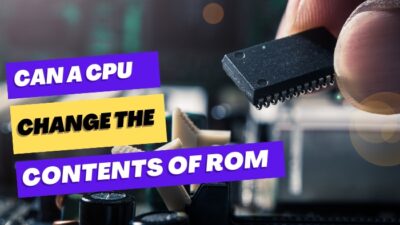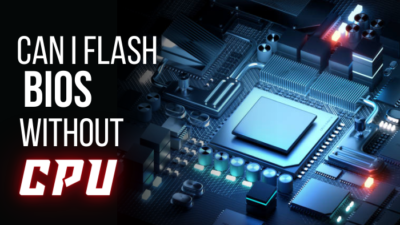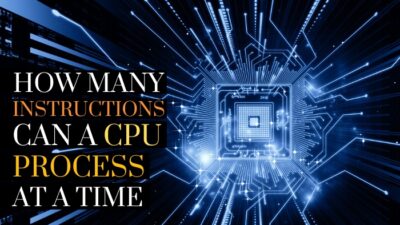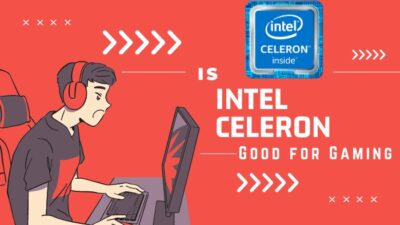Has it ever occurred that you’re in the middle of a duel with some random dude, and suddenly it starts to lag?
Consequently, the frame rate goes way beyond the playable limit. You’re likely facing that issue because of the bottleneck. It may be caused by a different component, but CPU and GPU bottlenecks are pretty common for the criteria.

Let’s immerse ourselves in the article and figure out more about how bottlenecks happen and how to avoid them.
What Is a CPU and GPU Bottleneck?
In general, When CPU usage is higher than GPU usage, then you have a CPU bottleneck, and it also means the app or game you are running is CPU reliant. On the flip side, when the application is GPU-intensive and occurs, the same issue – is a GPU bottleneck.
In simple words, can you imagine a big factory containing hundreds of employees? When the office hour ends, all the employees come out together. But the office gate is smaller compared to the number of people coming out. And it takes time to let out everyone. That’s the concept of the bottleneck.
Also, check out our separate post on can a Motherboard Bottleneck a CPU?
CPU Bottleneck
CPU bottleneck occurs when a CPU cannot keep up with other components, most notably with the GPU. It means that when the GPU processes data, but the CPU cannot keep up, it results in a CPU bottleneck.
The same thing happened to me as well. In 2019, and this is a good example of CPU bottlenecks GPU, I built a system for a friend with a Core i3-9100F and a GeForce GTX 1660 Ti 6 GB. I run some tests after the build and discovered that my processor is running at 100%, and my GPU is idling at 56% on average.
That’s how the CPU i3-9100F bottlenecks. Also, read our detailed discussion on how bad a CPU bottleneck can be for your PC.
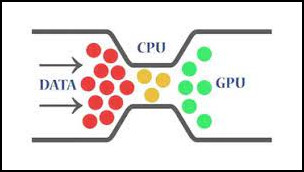
GPU Bottleneck
When a CPU outperforms a GPU or the graphics unit cannot keep up with the CPU, the GPU bottleneck takes place.
The CPU handles the action, audio, and other processes, while the graphics unit handles the visuals. If the GPU is unable to keep up with the CPU in these situations, it means the GPU bottlenecking the CPU.
Additionally, you should know whether to upgrade the CPU or GPU first, in case you face any bottleneck issues from either of these components.
Why Does CPU & GPU Bottleneck Happen?
Now let’s discuss why the bottleneck happens. You may think you have a slow processor compared to GPU or vice versa. But it depends on the game or apps you run.
Moreover, different games have separate factors to push the limit of the processor or graphics card. And there are games that are CPU or GPU-reliant.
Games like Total War: WARHAMMER 2, Grand Theft Auto 5, Far Cry 5, and Cities: Skylines are highly processor dependent. That means with a better CPU you get improved performance and the games will use a processor more than a GPU.
Also, games like Battlefield 5, Metro Exodus, Shadow of the Tomb Raider, and Red Dead Redemption 2 are highly graphics-reliant games. With better graphics, you will get higher FPS. And these games will utilize your GPU more than your processor.
Most of the time, if you bind a very high-end CPU with low-end graphics or conversely, then that might cause bottlenecking undoubtedly. But, bottlenecks do not alone depend on the PC components. Apps or games can push hardware dissimilarly.
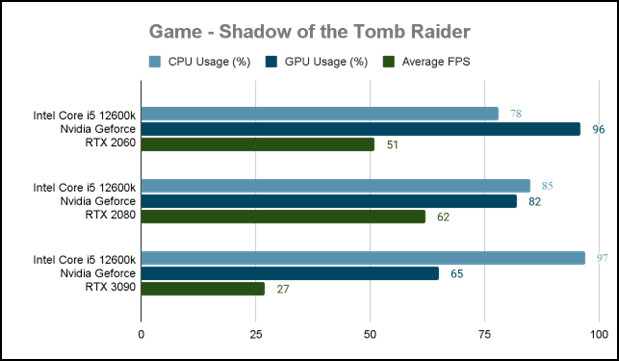
Here’s an example of how different hardware components can affect the gaming experience. For the processing unit, I used an Intel Core i5 12600k and three excellent graphics cards. As you can see, the 12600k and RTX 2060 get along just fine. As can be observed, the CPU usage is moderate and the GPU usage is high, which makes them both acceptable.
I replaced the GPU with an RTX 2080, and both CPU and GPU usage remained constant, as did the FPS.
Finally, with the RTX 3090, my CPU just started to fall apart. It is apparent that the CPU usage was maximum while the GPU usage was idling, indicating a high CPU bottleneck. And the FPS was abysmal, and the game was unplayable. Though the hardware modules are splendid, such a combination will simply not work in gaming.
Here is another example with the title Spider-Man Remastered.
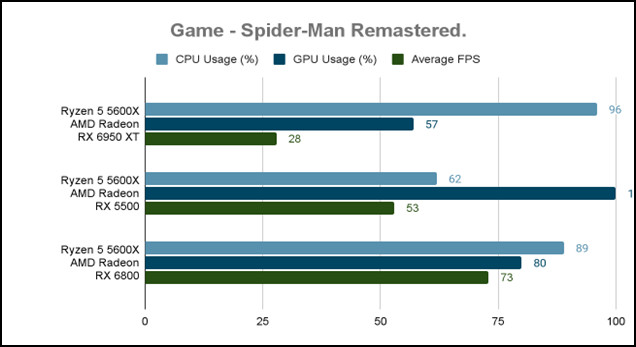
This time, I went with the Ryzen 5 5600X. My processor has never been able to compete with the AMD Radeon RX 6950 XT. This combination simply caused my CPU to bottleneck to the point where the game was no longer playable.
The heat was also unbearable. Besides that, an overheating CPU can cause a variety of problems with thermal throttling. The GPU bottlenecks significantly with the Radeon RX 5500. The GPU usage was always at 100%, and the FPS was low, but the game could still be played with adequate FPS.
Finally, Radeon RX 6800 is an excellent match for Ryzen 5 5600X. The usage was ideal, and the FPS was high. It’s a win-win situation.
Different apps or games, like components, can push hardware in a variety of ways. Thus causing the bottleneck. For example, when I play CS: GO on my Ryzen 3 3300X it runs smoothly but whenever I get into my Adobe Premiere Rush. It seems like the total system will crash and lags heavily for some time.
My CPU usage stays 100% for all cores, and my graphics card just relaxes. That’s how my CPU bottlenecks.
How to Determine Whether the CPU or GPU is Bottlenecking?
You can identify which one causes bottlenecking issues by monitoring your CPU and GPU usage. It’s possible to use the PC’s task manager, but for checking real-time usage it’s better to use proper monitoring software like MSI Afterburner, Prime 95, or HWiNFO.
You can use any of these to monitor your usage. Download any of those apps and install them on your system. Run the app when gaming and let the app monitor the hardware utilization. As I monitor with MSI Afterburner, here is the example.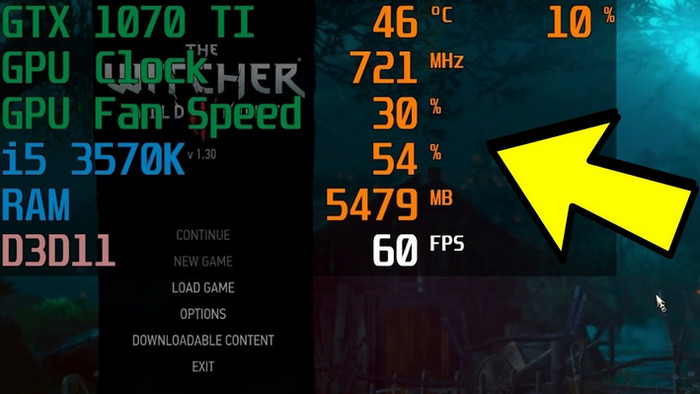 When gaming, observe the CPU and GPU usage. If the GPU usage is high and the central processor maintains an ideal state, then you have a GPU bottleneck. And if the result is the opposite of the first one, I mean the CPU usage is high and the graphics card continues in an ideal state, then the CPU is bottlenecking.
When gaming, observe the CPU and GPU usage. If the GPU usage is high and the central processor maintains an ideal state, then you have a GPU bottleneck. And if the result is the opposite of the first one, I mean the CPU usage is high and the graphics card continues in an ideal state, then the CPU is bottlenecking.
Furthermore, here’s our detailed guide on how to tell if the CPU is bottlenecking the GPU.
CPU or GPU? Which Bottleneck Impacts Gaming Performance?
To fully enjoy gaming, proper CPU and GPU bonding is required. So, how can you measure your game performance based on your level of experience? That is simply FPS. Frames Per Second are used to measure gaming performance.
60 frames per second is considered a target frame rate for enjoying any game. And 30 frames per second is only tolerable and the bare minimum.
You can predict framerate drops when there is a GPU bottleneck. However, when the processor becomes a bottleneck, the FPS becomes erratic. And the framerate fluctuates a lot.
There is also another term for RAM bottleneck. Memory bottleneck is equally bad as CPU bottleneck. When there is insufficient memory, the game simply restores to the swap point.
So, which is better, a CPU bottleneck or a GPU bottleneck? When gaming, it is preferable to have a GPU bottleneck. I’m not saying it’s required. If you have a bottlenecking problem, the GPU bottleneck is safer than the CPU choke point.
When having a GPU bottleneck, you can still play the game. But CPU bottleneck will just annihilate your gaming experience. And it’s better to fix CPU bottleneck when necessary.
How to Fix CPU and GPU Bottleneck?
Nobody enjoys bumping bottleneck problems. But if you still experience bottlenecks, there are some ways to resolve or lessen CPU or GPU bottleneck issues. And different approaches are used depending on the choke point.
Follow these methods to fix bottleneck issues:
1. Prevent Unnecessary Background Activities
It’s possible to reduce or fix bottleneck difficulties by stopping the workload running in the background. On modern PCs, many apps, and services are running in the background. And this causes high CPU usage.
You can find these apps and services with the help of Task Manager. Close the apps and services which are not necessary, and you will find a good boost in your performance. Apply these methods mainly if you encounter processor bottlenecks.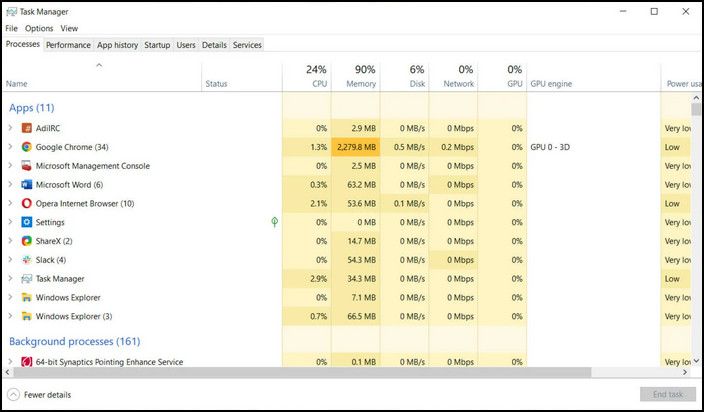
2. Enhance Game Resolution
If you encounter a CPU bottleneck, then the theory is your CPU is either unable to keep up with your GPU or your GPU just exceeds the CPU. You can fix these issues in the game setting by providing more tasks to the GPU.
Seems funny, right? If you raise the game resolution to the highest setting, then it will keep your GPU busy rendering and processing the data. Thus, the CPU will get more time to keep up with the GPU. And while this process is running, your CPU bottleneck will reduce.
3. Decrease In-game CPU Associated Settings
If the CPU and GPU usage are over 90%. You can lower the CPU bound settings. There are many games which are CPU bound. Games which have to cover more equations than graphical tasks are normally CPU bound games like WARHAMMER III, Civilization VI, Red Dead Redemption 2.
Changing these settings will not change the performance, however, it’ll create some breathing space for your CPU.
4. Overclock The Processor
By overclocking the CPU, you can utilize the utmost performance from your CPU. It also gives you more breathing room for your CPU. And before that, you need to know about your CPU’s overclocking capability.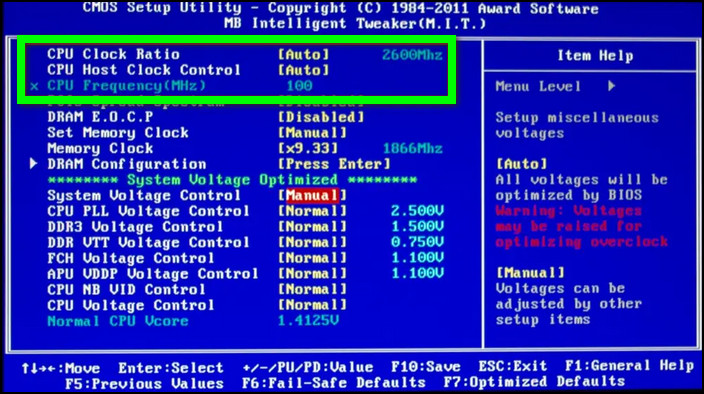
Before overclocking, you need to be sure about whether your CPU is overclockable or not. If possible, then overclock your CPU. And nowadays, most CPUs come with overclocking-enabled functionality.
As for CPU bottlenecks, there are some fixes for GPU bottlenecks. You can lower the graphics settings or overclock the GPU. That will ensure a more fluid game with better FPS.
And the window is always to upgrade the GPU. The primary concept is that a GPU bottleneck is less harmful than a CPU bottleneck. Because GPU bottlenecks don’t bring any damage in most cases.
FAQs
Which is worse, GPU bottleneck or CPU bottleneck?
A GPU bottleneck is much worse, especially right now. A GPU bottleneck implies that the GPU isn’t powerful enough to deliver a high, smooth framerate, but your CPU is. For example, a Ryzen 7 5700x processor with an Nvidia GT 1030 graphics card is a perfect example of GPU choke point.
Does bottleneck damage GPU or CPU?
When the CPU slows down, the GPU is also impacted and is unable to process the data fast enough. For this reason, the GPU will have a difficult time rendering the game’s frames, which will cause frame rate lag and poor performance. It’s crucial to remember that every machine has a CPU bottleneck of some kind.
What is acceptable, CPU or GPU bottleneck?
A CPU bottleneck is present if your CPU consumption is way greater than the GPU usage, and vice versa. Utilization rates of 50% or less are regarded as poor, those of 50% to 70% as typical, and those of 70% or more as high.
Does more RAM reduce bottlenecks?
Simply run Task Manager while you game and look at the performance tab to see whether you have a RAM limitation. You may require more RAM capacity if your RAM usage is at its maximum, or very close to it, in order to avoid a bottleneck.
Wrapping Up
In general, unbalanced components cause the bottleneck issue. And normally at the time of building a gaming rig, most of the people are more on the graphics unit. It’s best to get a balanced component for reducing bottleneck issues.
Some bottlenecks are not avoidable. But the theme is to get as little as possible. And at the time of heavy tasks, it’s best to get similar performance from the processor and graphics unit.
However, these different issues are from the same concept. I discuss through the article how this causes and how you can reduce them.

